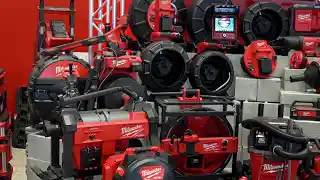How Much Pressure Will QuickFitting Hold? That’s the question on every plumber’s mind when it comes to quick-connect fittings. In the trades, performance and reliability mean the difference between a job well done and a call-back for leaks. In this write-up, we’ll dive into an in-depth pressure test—pushing QuickFitting (and a competing push-to-connect brand) to extreme limits inside a custom-built “blast chamber.” We’ll also explore how soldered joints compare under sky-high PSI. If you’ve ever wondered what your fittings can truly handle, this is your chance to see real numbers from an experiment in a controlled environment.
Building the Blast Chamber
Before getting to the real action, let’s talk about the setup. Applying thousands of PSI to piping is serious business. This is far beyond any normal residential or commercial water pressure (which is typically under 150 PSI). Pushing it to hundreds or even thousands of PSI demands both safety and specialized equipment.
A robust steel container, or “blast chamber,” is the only way to safely hold the pipe assembly while introducing compressed air or liquid at extreme pressures. The entire goal is to see if the fittings will burst before the pipe itself does. You need slow-motion cameras, multiple angles, and reliable gauges to record the moment of failure—if one occurs. For this test, the aim was up to 10,000 PSI capacity. That’s far above any real-world scenario but perfect for stress-testing.
What Is QuickFitting?
QuickFitting is a push-to-connect brand that uses an easy insert mechanism. Push the pipe in, and an internal stainless-steel grab ring and O-ring hold it firmly. The brand claims a 75-year warranty, which is quite significant when most push-to-connect rivals often top out at 25 years.
During the demonstration, sections of PEX and copper pipe were fitted together with QuickFitting couplings, elbows, and caps. Then the same approach was taken with the competing brand. Afterward, each assembly was placed in the blast chamber to see how high the pressure could go before leaks or catastrophic failure.
The Setup
All piping was prepared carefully. For PEX, each brand’s recommended stiffener or insert was used. For copper, short segments were cut and connected with push fittings. The experiment also included a piece with solder joints—just to see whether a well-soldered copper joint or the copper tube itself might give out first. The typical rating of PEX is about 160 PSI for continuous use, which is far below the thousands of PSI introduced in the chamber. Copper is often rated higher, but not into the thousands.
The test stand included a gauge reading beyond 1,000 PSI, with an ability to monitor up to 5,000 PSI and beyond. The plan was to crank the pressure slowly until something gave. A slow-motion camera inside the chamber would catch exactly what happened at the moment of truth.
Early Trials and Surprises
The first round featured PEX lines connected with QuickFitting on one side and a rival push-to-connect on the other side. Everyone expected that at a certain point, maybe a few hundred PSI, one fitting would pop or a pipe would balloon out. Instead, the assembly soared past 500 PSI, then 800 PSI, showing no leaks.
A next step was to keep going. At around 900 PSI, the competitor’s fitting started to fail, spraying water. Meanwhile, the QuickFitting side was still intact and holding. In some cases, the test was paused when one side leaked, while the QuickFitting side remained tight. Another surprise was that the PEX itself didn’t burst as quickly as predicted. Even though PEX is rated for about 160 PSI, it managed to withstand far higher numbers before any sign of stress.
Moving On to Copper
After the PEX tests, it was time to see how push-to-connect fittings held up on copper piping. A short length of copper was outfitted with both QuickFitting couplings and the competitor brand couplings. Once again, the blast chamber dialed up the pressure.
Surprisingly, even at 1,000 PSI, the QuickFitting side remained stable. The other brand showed leaking around 900 PSI or so. In some tests, internal parts of the rival fitting were ejected or the O-ring blew out, confirming that it couldn’t handle the same upper range.
Extreme Pressure Over 2,000 PSI
As the tests moved to higher thresholds, compressing past 2,000 PSI, we saw a few possible outcomes:
• The pipe itself might rupture.
• The fitting’s O-ring or retainer clip might fail, leading to a blowout.
• The entire fitting body could crack—though less likely if it’s brass or well-built.
In the actual results, QuickFitting soared into well over 2,000 PSI without bursting. One time, it reached 4,700, then 5,000, eventually beyond 5,200 PSI. At that stage, the test rig or gauge capacity started to max out. Even then, the QuickFitting might only start to drip or weep, rather than pop off completely. The competitor’s fitting had already leaked or failed at lower pressure.
The Soldered Joint Challenge
This was another highlight: a piece of copper with a standard, code-compliant soldered joint. Traditional soldering, if done right, can handle plenty of stress. But does it surpass push-to-connect in an extreme environment? This test revealed that you can push a properly soldered piece up to thousands of PSI, and it often won’t be the joint that fails. Instead, the copper tube might become a weak point, or the cap might stretch and tear open.
In these experiments, the pipe or the cap often deformed at very high PSI—sometimes around 6,800 PSI or more—before any solder joint gave out. That’s far beyond the normal household or commercial pressure you’d ever see. Still, it’s a testament to how reliable a correct solder job is, as well as how strong copper pipe is overall.
Key Takeaways
• Push-to-Connect Fittings Are Tougher Than You Think
The QuickFitting brand, in particular, consistently handled higher pressures than the competitor. In many trials, the competitor’s product started to leak or blow apart near 900–1,000 PSI, whereas QuickFitting soared past 2,000 PSI and, in some conditions, well over 5,000 PSI before any significant leakage.
• Pipe Material Also Matters
PEX might be labeled 160 PSI, but it can endure short bursts at far higher levels. Copper can handle thousands, but it can eventually bulge or tear if you go way beyond normal conditions.
• Soldering vs. Push-to-Connect
If done correctly, soldering can handle unbelievably high pressures. However, that requires skill, correct temperature, and consistent technique. QuickFitting, on the other hand, is a quick solution that still withstands more pressure than you’d ever expect in real-world plumbing.
• Other Considerations
It’s crucial to note these are extreme stress tests. No normal plumbing scenario should see 1,000 or 5,000 PSI. These results primarily demonstrate the margin of safety. QuickFitting’s 75-year warranty suggests the manufacturer’s confidence in its O-ring and retainer design. Some other push-to-connect manufacturers only back their fittings for 25 years. For professionals and homeowners who want both speed and security, that difference might be a big deal.
Warranty and After-Action Notes
• 75-Year Warranty
Yes, QuickFitting stands out with a 75-year coverage, indicating if a leak occurs due to manufacturing defect, they’ll replace and even compensate labor costs (depending on the specifics of the guarantee). This is huge for contractors who worry about product reliability in mission-critical applications.
• Usage
Push-to-connect fittings excel in tight spots or quick repairs, especially if you’re dealing with PEX or copper. They’re also great for add-ons or temporary connections. Soldering remains the old-school go-to for many plumbers, but QuickFitting’s performance in the blast chamber challenges the notion that push fittings are “weaker” than a properly soldered joint.
Why These Tests Matter
While you’ll never approach 1,000 PSI or more in a real pipe scenario, these trials show how much of a safety factor you might have. If a brand fails at 300 PSI in a controlled environment, maybe it’s not the brand you want behind your walls. The proven capacity well above typical operating pressure means fewer callbacks and more confidence.
Is QuickFitting Right for You?
For professional plumbers or serious DIYers:
• If your work demands speed, or if you face regular emergency calls, push fittings might save hours on each job.
• If you need future modifications—like rotating or disconnecting lines—a push design with a release collar is convenient.
• For new construction, some tradespeople still trust soldering or press fittings for large-scale consistency. But as these tests show, QuickFitting can absolutely keep up under stress.




